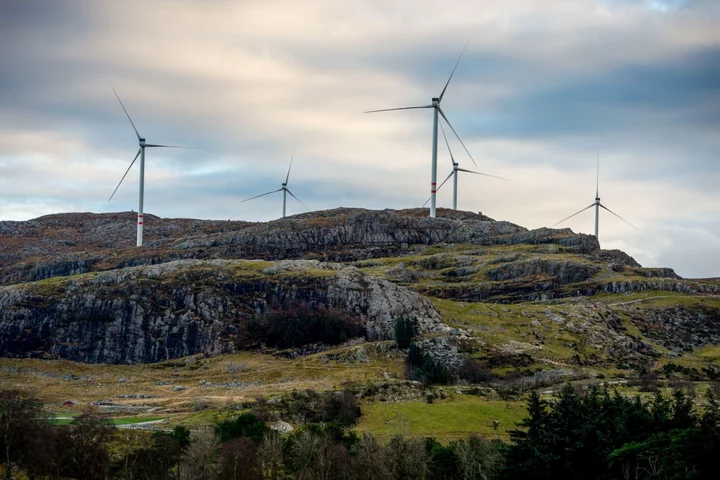As the US and EU throw billions at building out the industry needed for the transition to a low-carbon economy, Norway is spooking investors by slapping taxes on wind farms.
Norway’s Labor-Center government is boosting taxes as the cost of pensions, health services and care for the elderly outpace mainland revenues. Salmon farmers, wind turbine owners and hydropower producers are being asked to pay up for using the country’s fjords and mountains in a sweeping overhaul that has also targeted the wealthy.
Aquaculture companies were left unimpressed by the final proposal for their industry, even after outcry from companies saw it dialed back. That has left wind power firms on tenterhooks over their fate, and so far they don’t like what they see.
A proposed 40% tax on revenues from onshore wind parks has the potential to bankrupt projects and drive investors away, according to a KPMG report. That would be disastrous at a time when the country needs to add 40 terrawatts of green power production by the end of the decade to avoid an energy shortfall as factories and smelters move from gas to electricity.
“This cannot be achieved without extensive construction of onshore wind,” BlackRock Infrastructure Director Fredrik Norell and public policy analyst Jonathan Boyle said in a March 14 letter to authorities. The tax “throws the economics of wind power in Norway into doubt” and will “seriously damage investor’s confidence in Norway as a stable business environment and discourage new investments.”
The overhaul comes at a time when governments elsewhere are rolling out the carpet to attract green projects. Neighboring Sweden is forecast to grow onshore wind by 54% to 20 gigawatts by 2030, Finland sees a tripling in onshore capacity to 15 gigawatts, while in the UK land-based turbine capacity will almost double to 25 gigawatts by the end of the decade, according to BloombergNEF.
“Everybody else is welcoming onshore wind with open arms, except for Norway,” Jenny-Li Holmstrom, an investment manager at Finnish private equity firm Taaleri, said in an interview. “Investors are asking ‘why bother?’”
Known as Europe’s green battery, Norway’s industrial development was built on vast hydropower resources in its snow-capped mountains long before it discovered oil in the North Sea in 1969. Those dams kept electricity prices low, even as power consumption rose.
Successive Norwegian governments sought to cover this uptick in demand by incentivizing onshore wind investments, calling for a tripling of land-based turbines by 2020. That attracted international investors including BlackRock, Aquila Capital Holding GmbH and Luxcara, which today own over half of Norway’s 64 onshore wind parks, according to KPMG.
Those companies represent risk adverse investors who were drawn to the country’s “stable political, social and legal environment,” Luxcara said in a March 15 letter to the government.
It didn’t take long, however, for the turbines to stoke controversy. There were complaints that the installations marred Norway’s scenic landscape and spooked the reindeer herded by the Indigenous Sami. In 2021, the supreme court ruled that two wind parks built on grazing land breached their human rights. After lack of action by the government, protesters - including Greta Thunberg - blockaded government buildings earlier this year, demanding that the turbines be torn down.
The furore, coupled with the tax proposal, leaves investors considering their options. Norwegian wind developers Cloudberry and Aneo, as well as Hamburg-based Luxcara, are among the companies now turning their focus to markets outside Norway.
“The whole renewable sector in Norway has been clear that this cannot be the final result,” Cloudberry CEO Anders Lenborg said on March 8. “I can’t understand how this should be part of the solution to get enough renewable power.”
Meanwhile, Norway’s push to decarbonize is only growing more urgent as it targets cutting carbon emissions by at least 55% from 1990 levels by the end of the decade. As onshore wind became less popular, the current government - due to release its revised budget Thursday - is pushing hard for placing turbines out at sea, where it aims to complete 30 gigawatts of capacity by 2040.
Offshore wind farms, which so far don’t face the same taxes as their onshore counterparts, don’t arouse similar opposition from local residents. They also offer an alternative for the country’s oil and gas companies as they transition to more renewable operations, making the most of their experience working in the North Sea.
That sector has formed the backbone of the tax system in Norway, with oil and gas companies facing a total marginal tax rate of 78%, explaining why the government is so willing to put more tariffs on profiting from the use of natural resources. Petroleum taxes have helped build a $1.4 trillion sovereign wealth fund, which covers budget deficits. The proposed taxes on wind producers, hydropower operators and fish farmers are expected to add more than 30 billion kroner ($2.8 billion) to state coffers annually, according to the original proposal in September.
But like other European countries last year, Norwegian consumers struggled with high energy prices, inflation and other knock-on effects related to Russia’s invasion of Ukraine. And as it electrifies everything from cars to offshore platforms, the warnings of the country’s grid operator make it clear that significant investment is needed in its electricity system, hydro plants and wind parks.
“To put it simply, we have very little time to get a lot done,” Gunnar Lovas, a senior director at Statnett, said in November. “Faith in investment in power production becomes completely dependent on whether investors dare to build new capacity.”
--With assistance from Rob Dawson.
(Updates with revised budget date in 14th paragraph.)









